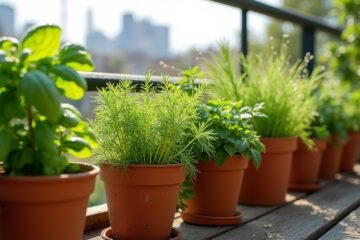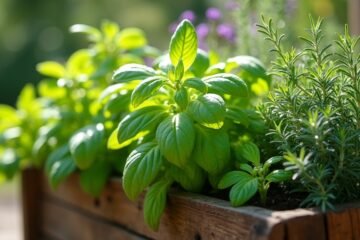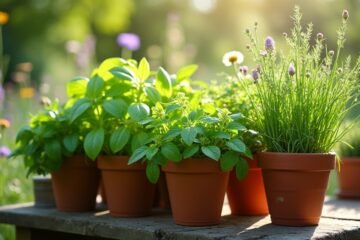Want to transform your space into a fragrant herb haven? Start with vibrant pots that reflect your style! Next, choose rich, airy soil for happy herbs—like fluffy clouds for their roots. Don’t forget drainage; no one likes soggy feet! Water wisely, check for dry tops, and think of your herbs as your culinary cheerleaders—prune them for bolder flavors! Pair herbs wisely and keep pests at bay. Stick around to uncover even more exciting tips for your garden adventure!
Choose the Right Containers
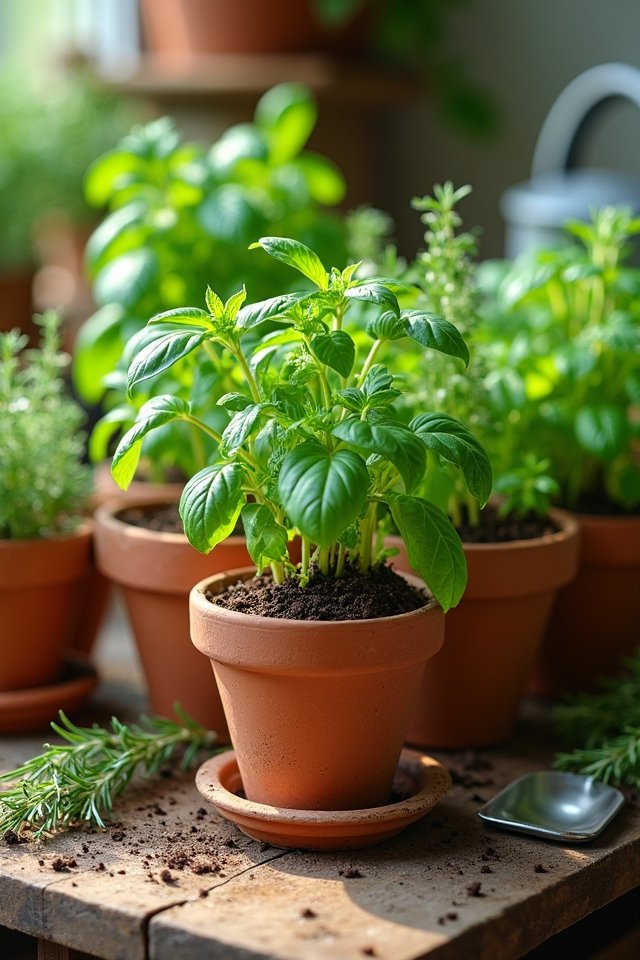
When you’re diving into the world of container herb gardening, choosing the right containers is like picking the perfect outfit for a big day out—you want style, comfort, and the right fit! Imagine vibrant terracotta pots, their earthy tone complementing your fresh basil, or sleek metal containers adding a modern twist to your mint collection. Your herb container styles can either reflect your personality or simply fit in with your home décor!
And don’t forget about container material choices; lightweight plastic makes moving a breeze, while sturdy ceramic keeps plants cozy. Are you feeling adventurous? Go for a repurposed wooden crate! The right choice not only tells a story but also creates a happy home for your herbs!
Select Quality Soil
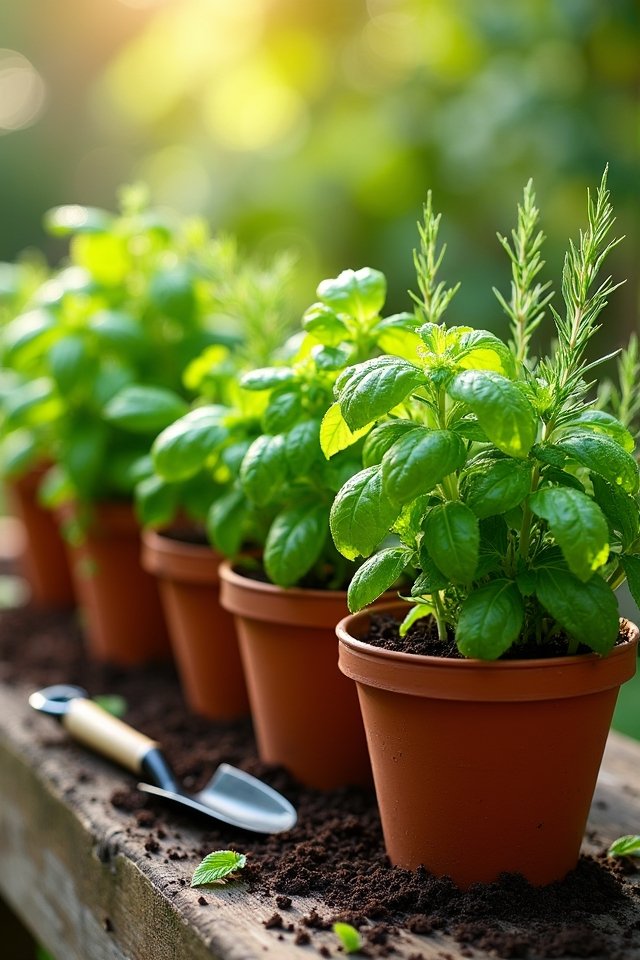
Choosing the right soil for your container herb garden is like picking the perfect foundation for a fantastic cake! You want rich, well-aerated soil that promotes growth and creativity. Explore various soil types like potting mixes that blend organic matter and peat, offering your herbs nutrition and moisture retention. Remember, the ideal soil pH for most herbs is between 6.0 to 7.0—just like the sweet spot for a delicious cookie! You can grab a pH test kit at your local garden center to verify your soil isn’t too sour or sweet. Don’t skip this step; it’s essential! Fresh basil or mint can flourish in the right mix, making your culinary adventures even more delightful! Happy planting!
Ensure Proper Drainage
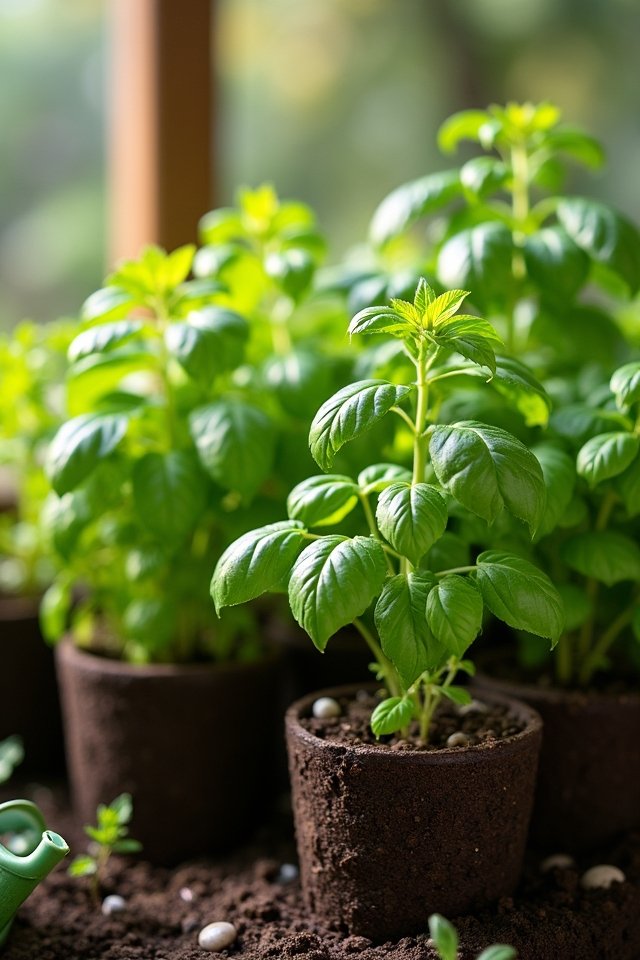
While it might seem tempting to simply fill your container with soil and call it a day, ensuring proper drainage is a game-changer for your herbs! Imagine your beloved basil drowning in soggy soil—yikes! You can easily avoid this fate by choosing innovative drainage materials like gravel, perlite, or coconut coir. Different container types, from ceramic to plastic, can affect drainage too! Make sure to punch holes in the bottom of your pots, letting excess water escape like a little safety valve for your herbs. A well-drained container means happier, healthier plants, bursting with flavor! So take a moment to enhance your herb garden and watch those vibrant flavors flourish like a sunny day! Isn’t that what you want?
Position Containers Strategically
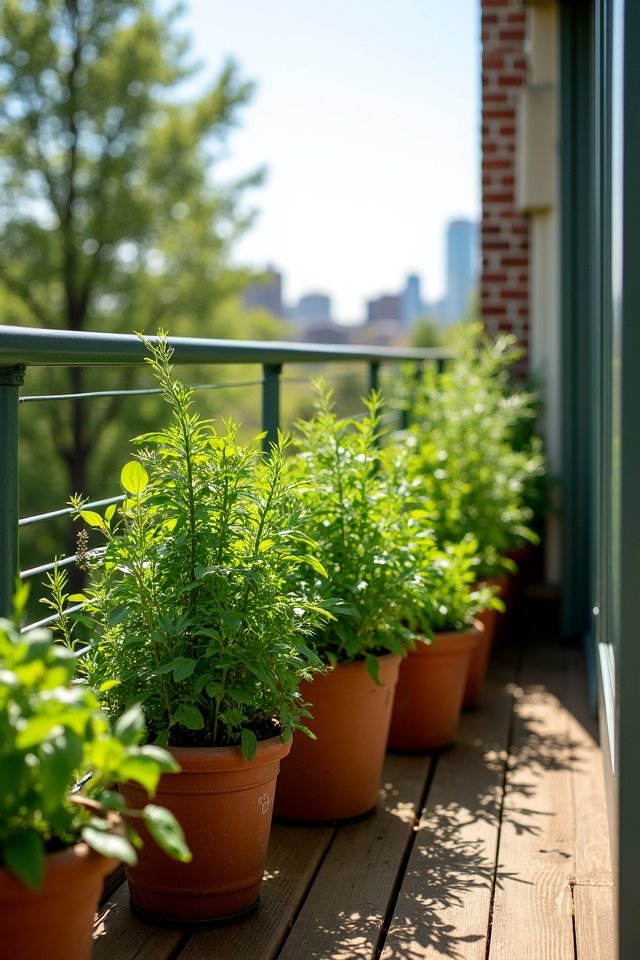
After guaranteeing proper drainage, you’ll want to think about where to place your containers. Opt for spots that maximize sunlight exposure—think of your herbs as sunbathers! Additionally, don’t forget about wind protection. A gentle breeze can be invigorating, but strong gusts might whip your plants into a frenzy!
Here are three key considerations for positioning:
- Sunlight: Position containers in locations that receive at least six hours of sunlight.
- Shelter: Place them near walls or fences for wind breaks.
- Accessibility: Confirm you can easily reach them for pruning and harvesting.
It’s like giving your herbs a cozy home where they can thrive, right? Your flavorful friends will thank you!
Watering Techniques
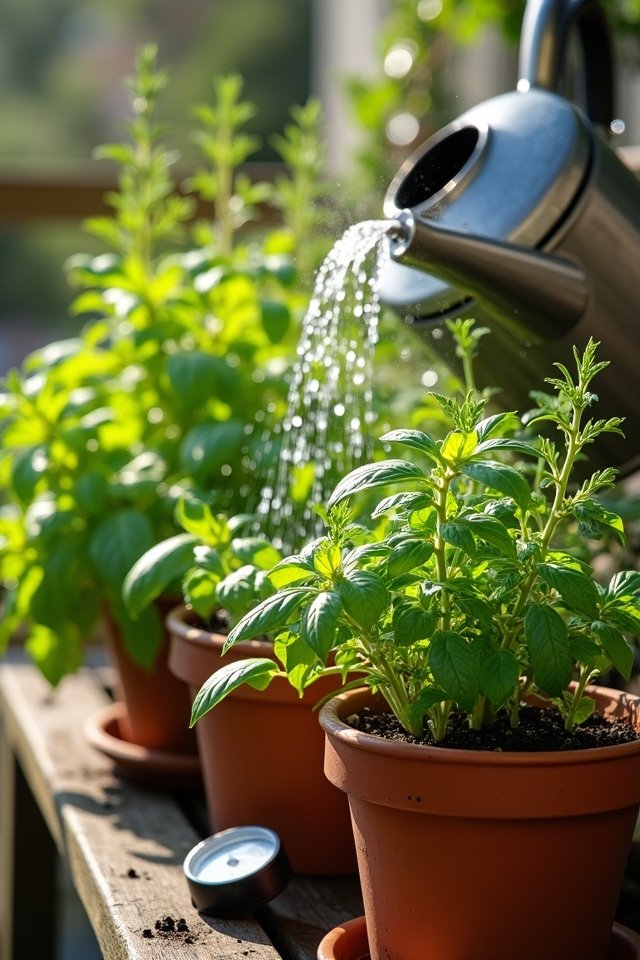
Watering your herb garden is like giving your plants a revitalizing drink on a hot day! To keep those vibrant greens happy and thriving, consider using drip irrigation. This clever system guarantees your herbs receive water directly at the roots, promoting excellent moisture retention while preventing puddles that could drown your precious plants. Try watering in the early morning or late afternoon. You wouldn’t want a sunburn, would you? Plus, the cooler temps help minimize evaporation! Keep an eye on the topsoil; if it feels dry one inch down, it’s time to hydrate! Just remember, overwatering can be just as deadly as under-watering. Balance is key, so give your herbs that revitalizing sip they crave!
Fertilization Guidelines
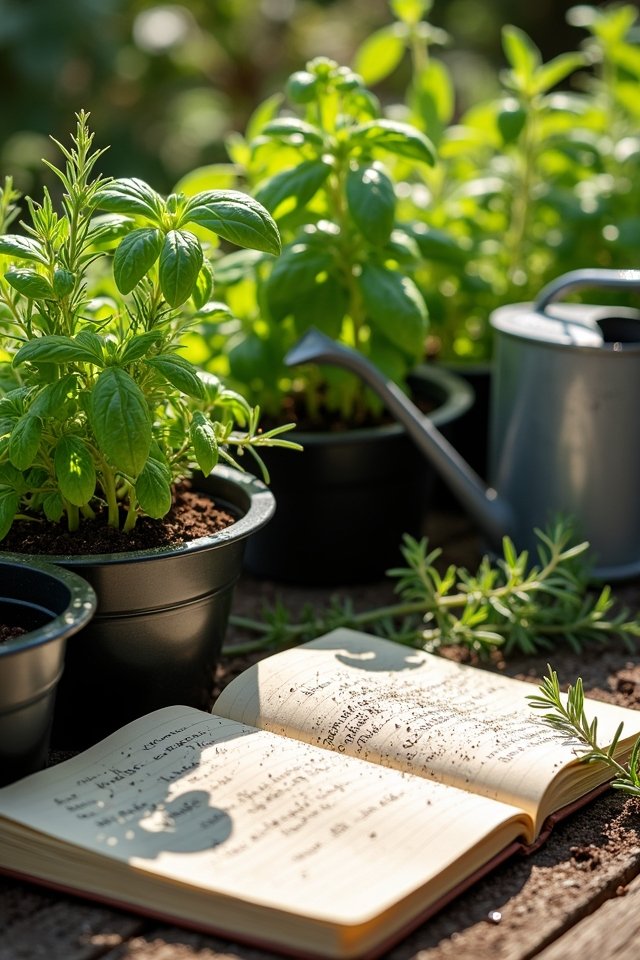
Fertile soil is the secret sauce to a thriving herb garden! To keep your herbs lush and vibrant, follow these innovative fertilization guidelines:
- Choose organic fertilizers: They’re like a gourmet meal for your plants! Look for options like compost or worm castings.
- Opt for slow-release options: These work like a relaxing vacation for your herbs, delivering nutrients gradually over time.
- Feed every 4-6 weeks: Think of this as a monthly spa day. It keeps your herbs rejuvenated and ready to flourish.
Pruning and Harvesting
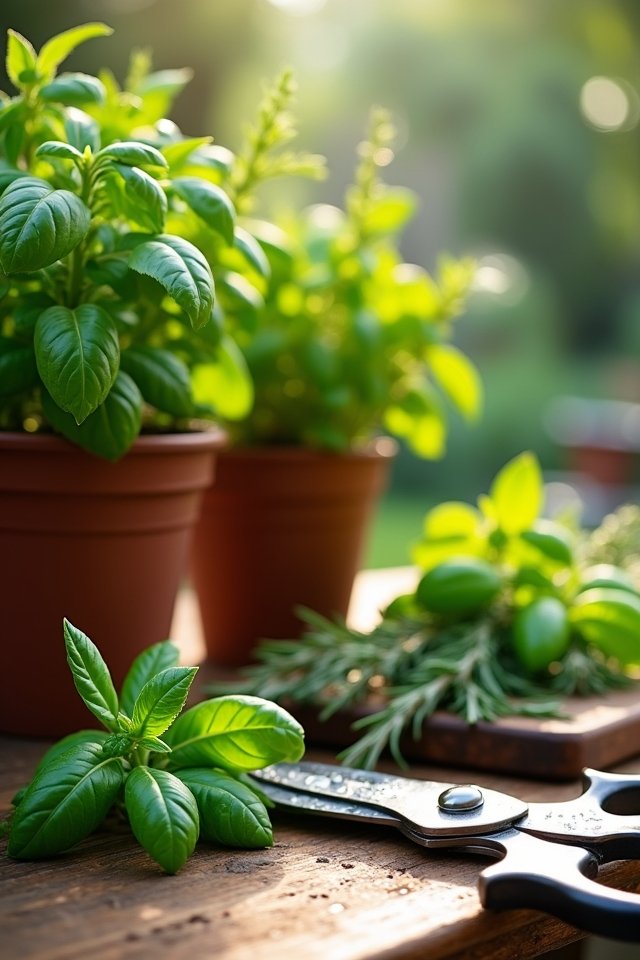
Now that your herbs are well-fed and thriving, it’s time to give them some love through pruning and harvesting! Pruning techniques like pinching off leaves encourage bushiness and guarantee your herbs keep growing strong. Go ahead, snip those tops—it’s like giving your plants a stylish haircut! As for harvesting methods, clip sprigs with scissors rather than yanking them out; it’s gentler and promotes fresh growth. Did you know that harvesting your herbs regularly actually boosts their flavor? When you taste that fresh basil or tarragon, you’ll wonder why you didn’t do it sooner. So, roll up your sleeves, get a little messy, and savor the joy of your thriving herb garden—your culinary adventures await!
Pest Control Methods
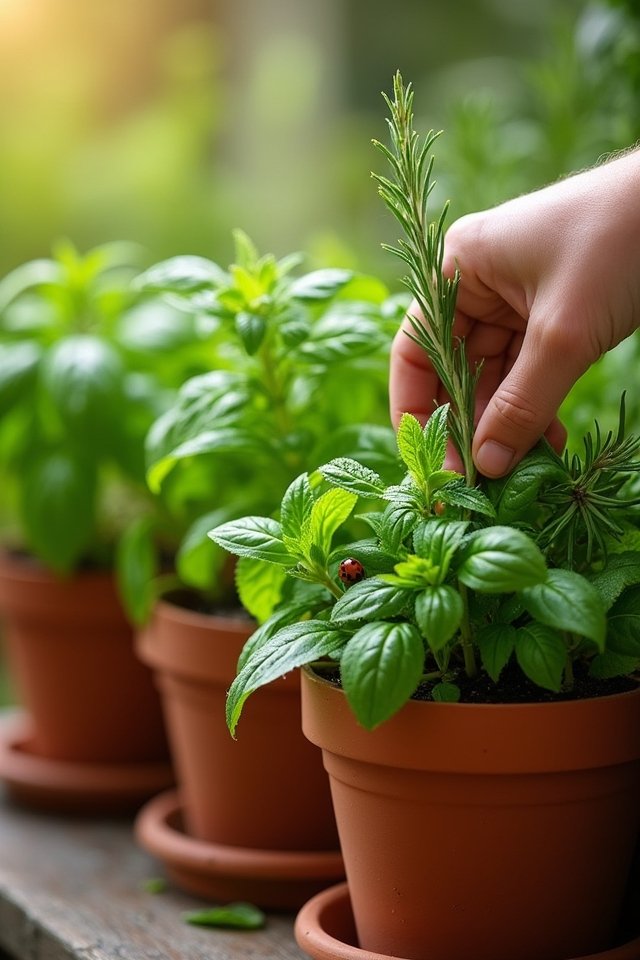
When you see those pesky little bugs munching on your beloved basil, it can feel like an invasion straight out of a horror movie! But fear not; you’ve got some innovative pest control methods up your sleeve. Here are three effective strategies:
- Natural repellents: Spray a mix of water and crushed garlic or pepper on your plants. Those bugs won’t know what hit them!
- Companion planting: Introduce beneficial insects like ladybugs or lacewings. They’re like little superheroes battling the pests for you!
- Diatomaceous earth: Dust this fine powder around your herbs; it’s like a slippery trap for soft-bodied bugs!
With these tactics, you’ll defend your garden and keep it thriving. Bye-bye, bugs! Hello, fabulous herbs!
Seasonal Care Tips
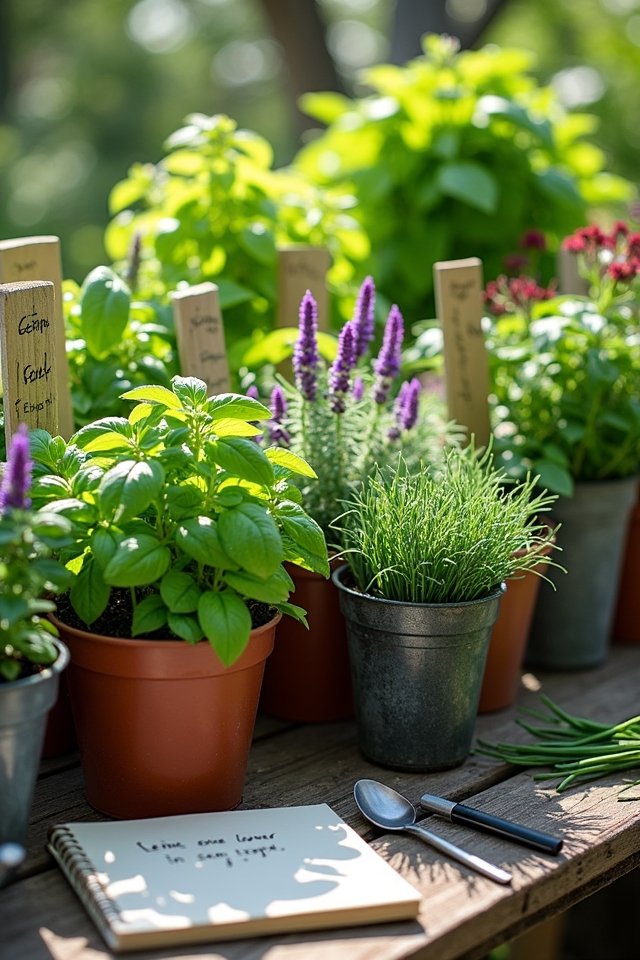
As the seasons shift, your container herb garden needs a little TLC to stay vibrant and productive! Welcome seasonal planting by swapping out your herbs with each new season. For instance, in spring, think fresh basil and mint, while winter calls for heartier options like thyme and rosemary! Keep weather considerations in mind; if frost threatens, bring your herbs indoors for a cozy reprieve.
Don’t forget to check moisture levels—too much can drown, while too little will shrivel your greens! Add a splash of liquid fertilizer every month to rejuvenate those flavors. Let’s get creative; how about a rosemary topiary? Your herb garden can be a culinary masterpiece, revealing aromatic splendor in every dish! Happy gardening!
Companion Planting Benefits
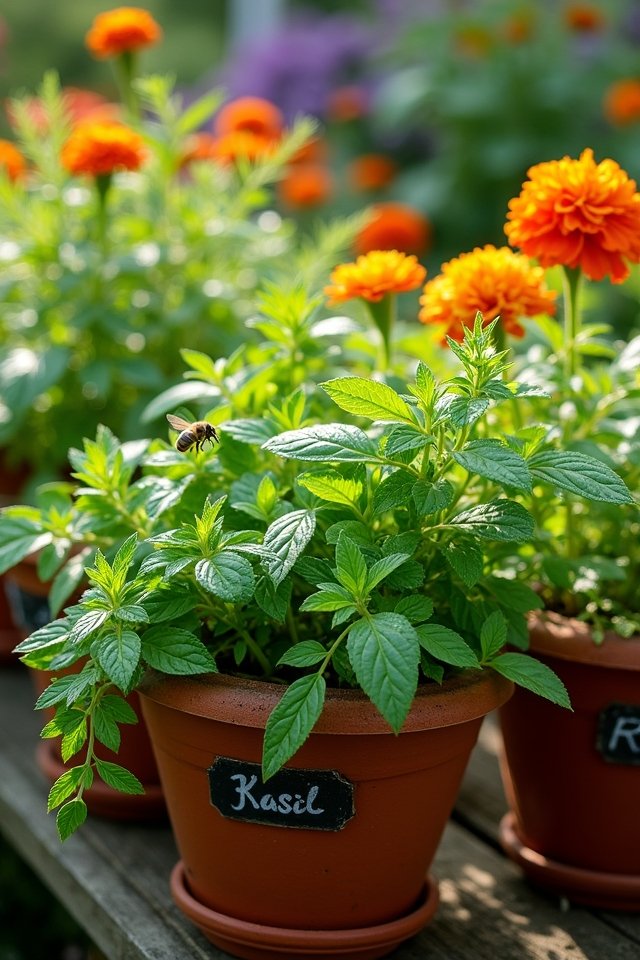
Have you ever wondered how your herbs could thrive even better together? The magic of companion planting showcases how smart herb pairings can create plant synergy, making your garden flourish like never before! Here are three fabulous benefits you’ll love:
- Enhanced Growth: Some herbs can boost each other’s growth, giving your container garden that extra oomph! Basil loves to hang out with tomatoes, for example.
- Pest Control: Certain herb combinations act like natural pest repellents! Planting mint alongside carrots might keep pesky bugs away.
- Flavor Boost: Flavors can be amplified when certain herbs grow together. Dill and cilantro make a dynamic duo for delicious dishes!
Embrace these benefits, and watch your herb garden transform into a flavorful paradise! 🌱
Frequently Asked Questions
How Much Sunlight Do Herbs Need in Containers?
Herbs in containers thrive best with at least six hours of direct sunlight daily. Think of sunlight as their favorite snack! For ideal placement, choose a sunny patio or balcony, where they can soak in those glorious rays. Just imagine the fresh scent of basil and mint—yum! If your space lacks sun, don’t fret! You might consider rotating them for a sunbathing session or adding a grow light. Happy herb gardening!
Can I Grow Herbs Indoors Without Natural Light?
Sure, you can absolutely grow herbs indoors without natural light! Think of it like creating a cozy little greenhouse right in your kitchen. Artificial light options, like LED grow lights, act like the sun, encouraging your herbs to flourish. Imagine fresh basil ready for your pasta or mint for your tea! Just remember to keep those lights on for about 12-16 hours a day, and you’ll be well on your way to thriving indoor herb gardening!
What Are the Best Herbs for Beginners to Grow?
Looking to sprout some goodness in your kitchen? Start with easy-to-grow herbs like basil, parsley, and cilantro! These popular culinary herbs not only flavor your dishes but also make your space vibrant and alive. Imagine the sweet aroma of basil wafting through your home! With just a little love and water, you’ll have a mini herb paradise. So, why not jump in and let your green thumb shine? You’ve got this!
How Often Should I Repot My Herb Plants?
You should keep an eye on your herb plants’ growth! Generally, repot every 1-2 years or when you notice roots peeking through the drainage holes. If your container gets too snug, it’s time for a bigger home! Consider upgrading to a container size that’s at least 2 inches wider. Your herbs will thank you with a lush, flavorful flourish. After all, who wouldn’t want a thriving garden like a sunlit oasis?
What Herbs Can I Grow Together in the Same Container?
So, you thought growing herbs together would be a recipe for disaster? Think again! Welcome herb companion planting with basil, parsley, and chives in your container garden design. These aromatic pals thrive side by side, creating a delightful harmony of flavors. Picture a mini herb haven, where basil’s sweet aroma mingles with chives’ oniony zest! Just imagine the culinary magic! Who knew gardening could be this fun and fragrant? Get planting!
